Learning the friendly way
Dive into our resources, guides, and articles for all things money-related. Grow your financial confidence with our experts curated tips and articles for both experienced and new investors.
LATEST ARTICLEs

Whether you're trying to navigate the world of Crypto Twitter or preparing for Web 3.0, understanding the lingo is imperative to understanding the information available and fitting in. You might be very familiar with the English language, but don't let that fool you, crypto slang on social media is a language of its own.
While you might be familiar with concepts such as mining and smart contract, here we upgrade you to the next level of crypto jargon content. Below we run you through the 20 biggest acronyms and terms you need to learn when embarking on your Crypto Twitter journey. Good luck!
20 Top crypto terms and acronyms
Apeing In
Apeing in refers to buying a token or more commonly an NFT right after launch without doing the necessary research. Also sometimes expressed as "I aped", this is usually a result of being fearful you're going to miss out on potential gains. Always DYOR.
Bag Holder
This term refers to an investor that is holding a cryptocurrency or NFT that they cannot sell for a higher price, and cannot sell at the current price (as it is too low). While this isn't entirely negative, it's not very positive either. Bag holders will simply need to wait out the market dip.
BUIDL
First made famous by Ethereum founder, Vitalik Buterin in 2018, buidl is an obvious typo of the word build and refers to "build useful stuff". The concept revolves around developers utilizing blockchain technology, to hopefully, provide a solution to the industry as a whole.
BTFD
Standing for Buy The F** Dip, BTFD has been described as a "prominent investment lesson". Buying the dip is when investors accumulate cryptocurrency during a bear market when the prices are trading at less than their value. Quoting Warren Buffet, "be fearful when others are greedy, and greedy when others are fearful."
DAO
DAO stands for decentralized autonomous organization and acts as a form of venture capital funding, replacing a board of directors with open-source coding. Operating entirely automatically, everyone is granted ownership and is involved in the decision-making. DAO essentially describes the structure of Web 3.0 companies.
dApps
You may be familiar with this term already, decentralized applications are any digital apps built on top of a blockchain network. Instead of operating off of a centralized computer system, dapps harness the power of blockchain and are maintained and operated by the network on which they're built.
Ethereum, Solana and Cardano are popular platforms on which developers built their dapps, with no limit to what industry these dapps can be built for, from payments to entertainment to supply chain management.
Diamond Hands
This term refers to an investor who will never sell. Diamond hands push through the losses, gains and volatility, resisting the dips and the peaks. These are hardcore hodlers who strongly believe in a project's vision.
DeFi
Another term you're likely to have come across is decentralized finance, DeFi. DeFi is a sector of the crypto industry that provides traditional financial products and services only using blockchain technology, like lending, borrowing and providing liquidity. The aim of DeFi products is to remove the centralized nature of banking and make things more accessible to the masses. PancakeSwap, Aave and The Graph are examples of DeFi platforms.
Degen
Degen is short for degenerate risk-taker, someone who makes highly risky bets without due diligence. While this is typically frowned upon in the real world, in the crypto world this is a badge of honour. Being a degen and making money fast is the ultimate flex. We still recommend that you DYOR beyond just the project's website.
DYOR
Possibly the most important phrase when it comes to investing in cryptocurrencies and NFTs: always do your own research. Never follow anyone's advice blindly, no matter how much money they've made, instead always look into a project before investing in it. DYOR takes a firm stand in reminding you that you are accountable and responsible for your investment choices.
GMI
A term of endearment in the crypto space, GMI stands for Gonna Make It, used to reassure someone that they're on the right track. Often thrown around on Twitter and Discord, GMI offers someone an affirmation in their decisions.
On that note, NGMI stands for Not Gonna Make It. Usually used when someone makes a mistake or does something crazy, or when someone makes ignorant comments about the crypto space when they know little about it. It can be brutal out there, but DYOR and you'll be ok.
Genesis Collection
Similar to how the first block on a blockchain is referred to as the genesis block, a genesis collection is the first NFT collection created by an artist. Buying items from a genesis collection is a symbol of early support and usually comes with some added benefits. Following the transaction for the digital currency, holders might be treated to early releases, insider info or concert tickets.
HODL
While we're familiar with what HODL refers to (holding onto a cryptocurrency for a long time in order to tap into possible future gains), many might not be aware that it has been gifted an acronym of its own. We say gifted because the term originated from a typo in a Bitcoin forum. HODL has affectionately been expanded to Hold On for Dear Life, encouragement for when markets dip and weak hands consider selling.
Metaverse
A hot topic at the moment, but do you know what it means? The metaverse refers to an alternative reality that exists in the digital realm. This digital space allows users to work, play, socialize and do business, interacting with others as they do. The metaverse can be described as a combination of VR (virtual reality), AR (augmented reality) and 3D worlds.
NFT
This is a big one. It stands for Non-Fungible Tokens and refers to anything that someone can create store and sell on the blockchain but is not fungible. Each NFT is unique and cannot be used interchangeably like most other cryptocurrencies. Also note that an NFT is a token standard and can be built on various blockchains, while ETH for instance is the native token to Ethereum and cannot be used by other blockchains.
Shill
Shill refers to someone promoting a particular cryptocurrency to create excitement for it, usually to their own financial benefit. The purpose of shilling a coin is to generate hype that will hopefully lead to mass buying. Most platforms frown against shilling as it's essentially part of the same family tree as pump and dumps.
Paper Hands
The opposite of diamond hands, paper hands are quick to sell, often too early. Giving in to pressure and volatility, paper hands sell when the financial risk is too high (as opposed to waiting out the dip).
P2E
P2E stands for play to earn and is a concept in gaming where players can earn an in-game asset that holds value outside of that ecosystem. Axie Infinity, for example, is a game in which users can earn AXS, which is traded on many big exchanges. Gods Unchained and Evaverse are other P2E games.
RUG
Sometimes referred to as a "rug pull", rug is used to describe a situation where the founders of a project run away with the raised funds. These scams are not uncommon in the unregulated world of cryptocurrencies, however, they have become much fewer and far between since the earlier days. Their actions often send the crypto price plummeting to zero and cause huge losses among investors.

The global financial crash in 2007 was the catalyst for the creation of Bitcoin. Designed to provide a decentralized way in which people can manage their own money, digital currencies slowly infiltrated the greater financial markets.
Almost a decade later, crypto adoption is at its highest and for the first time challenging traditional financial institutions and their product range. So, which is better? Let's explore the pros and cons of each category.
Blockchain technology has seen an incredible increase in interest in the last few years. While it provides a universal backbone relevant to almost any industry, it has also brought the world cryptocurrencies, NFTs, decentralized finance (DeFi) and other digital assets.
Tackling existing centralized monetary challenges, blockchain technology and digital currencies are two of the greatest inventions of the 21st century.
Digital currency versus banking
Cryptocurrencies are decentralized digital currencies that can be used to exchange goods and services as well as a store of value. They're typically acquired through crypto exchanges and kept in secure crypto wallets. These virtual currencies are autonomous, operate in a secure manner with little human interaction, and are increasingly considered the future of finance.
The predominant financial systems in the world are currently banks. They provide financial services to those that meet their requirements, including loans, savings, and other financial services.
However, unlike cryptocurrencies, they have several problems core to them being centralized and susceptible to biases. They're also slower than cryptos, and some of them charge exorbitant interest rates on loans as well as routine purchases.
The pros and cons of the Banking system vs digital currencies
There has been little development in the banking sector in the last several decades, so while the products are useful there has been very little innovation in the space. Below we outline the current challenges that the traditional systems face when compared to the advantages of a digital currency.
Financial Inclusivity
Banks are notorious for requiring lengthy paperwork and in-depth background checks. They are also known to provide different products and limits to different groups of people, including payment durations, soft loans, limits, etc.
When creating the digital currency Bitcoin, Satoshi Nakamoto wanted to counteract this financial inclusivity pertaining to fiat currencies and the greater financial system and instead provide a financial product available to all. Cryptocurrencies, therefore, do not require any paperwork or identification to operate or open a digital wallet.
While buying digital assets on an exchange will require personal information, they do not require any background checks or credit scores. Unlike in the traditional financial system, engaging in crypto markets is also not exclusive to location, allowing anyone from any corner of the globe to immediately access the digital payment systems.
Accessibility
Banking institutions operate within certain hours and are closed on weekends, meaning that transactions can sometimes take days to clear. They will also typically require an in-person authentication for very large transactions, and affect the remittance markets in the global financial system.
Cryptocurrencies on the other hand operate 24/7 (even on public holidays) as they are maintained by members all around the world. Cryptocurrencies provide zero downtime with unlimited amounts and do not require third-party authentication before making transactions. One digital currency can send value to the other side of the world in minutes, requiring no in-person authentication.
Security
The banking industry, particularly online systems, are susceptible to being hacked, alongside fraudulent activities and money embezzlement. While this is not always the direct fault of the central bank or financial institutions, it has become a common problem as ill actors have learned how to navigate the security systems and trick the owners of these accounts.
Through the use of blockchain technology, transactions cannot be intercepted or reversed, and are handled in a peer-to-peer nature ensuring that they do not go through a third party for authentication and require minimal human interference.
Fees and Transaction Times
During transaction periods, banks often add on extra costs and taxes. When sending and receiving money, banks frequently charge very high transaction fees and taxes, especially when conducting international remittances. These transactions also take a long time to clear due to their sluggish procedures, especially for large amounts of cash.
Cryptocurrencies provide an excellent solution to the remittance markets as they provide fast and cheap transactions. Blockchain technology ensures that they clear in several minutes (depending on the cryptocurrency and the network’s congestion at the time) and that they are sent directly to the recipient’s wallet (as opposed to waiting for the receiving bank to clear the transaction).
Diversification
Traditional banking services generally lack significant diversification options due to their competitive pricing structures. However, cryptocurrencies enable users to engage with multiple products simultaneously, which can provide opportunities for leveraging various networks and creating portfolios with reduced risk concentration.
Smart Contracts
Another advantage that blockchain currently holds over traditional banking systems is the use of smart contracts. Smart contracts are digital agreements that automatically execute once predetermined criteria have been met. Leveraging smart contracts in the financial services industry offers a seamless and entirely decentralized approach to modern banking.
Which is Better: The central bank or digital assets?
Comparing central banks and digital assets reveals intriguing aspects of both systems. Banking systems have become an integral part of modern society, underpinning economies and facilitating everyday financial transactions. They offer stability, regulatory frameworks, and familiarity to the masses.
On the other hand, cryptocurrencies introduce a realm of innovation. Their decentralized nature challenges traditional financial paradigms, enabling secure and direct peer-to-peer transactions. Additionally, cryptocurrencies empower novel applications such as smart contracts, decentralized finance (DeFi), and tokenization of assets.
Selecting one over the other isn't straightforward due to their contrasting strengths. Central banks provide stability and a well-established foundation, while digital assets spark possibilities for disruption and financial inclusivity.
Presently, these financial systems coexist synergistically. The banking system maintains its role as a bedrock for economic operations, while digital assets complement by offering alternative avenues for value exchange and financial exploration. As both systems continue to evolve, it's likely that their interaction will shape the financial landscape in intricate and unexpected ways.
Why not use both? Tap offers the perfect solution to merging the best of both worlds through an innovative alt-banking mobile app. Through the app, users can load both fiat and cryptocurrencies into their unique, secure digital wallets and use both interchangeably to pay bills, send money to friends, and even earn interest. Get the best of both worlds by enjoying the benefits of both the traditional banking systems and cryptocurrencies.
Why not harness the strengths of both paradigms? Embracing this dual approach, Tap presents a groundbreaking solution that seamlessly blends the attributes of both money accounts and digital assets within an innovative mobile application. Tap empowers users to effortlessly load fiat currencies alongside cryptocurrencies into their individualized, secure digital wallets.
This fusion enables users to fluidly alternate between these assets for various purposes, such as settling bills, conducting peer-to-peer transactions, and even capitalizing on interest-earning opportunities. By embracing this convergence, you can truly enjoy the advantages offered by both traditional finance and the dynamic potential of cryptocurrencies.

Comprendre la valeur nette
Que vous soyez investisseur, épargnant ou que vous souhaitiez simplement mieux gérer votre budget, connaître votre valeur nette est une étape essentielle pour prendre le contrôle de votre situation financière. Cette donnée vous donne une vision claire de votre patrimoine et vous aide à prendre des décisions plus éclairées.
Contrairement au revenu, qui reflète ce que vous gagnez à un moment donné, la valeur nette donne une vue d’ensemble à long terme en tenant compte de ce que vous possédez (vos actifs) et ce que vous devez (vos dettes).
Quels éléments influencent votre valeur nette ?
Vos revenus
Le revenu regroupe vos différentes sources de gains : salaire, investissements, revenus secondaires… Plus vous gagnez, plus vous avez de potentiel pour augmenter votre patrimoine. Mais l’accumulation de richesse ne dépend pas seulement de ce que vous gagnez : elle repose aussi sur votre gestion des dépenses.
Vos actifs
Les actifs sont tout ce que vous possédez qui a de la valeur : épargne, biens immobiliers, portefeuille d’investissement, voiture… Diversifier vos actifs et miser sur ceux qui prennent de la valeur peut contribuer à faire croître votre patrimoine.
Vos dettes
Les dettes diminuent votre valeur nette. Elles incluent : prêts immobiliers, crédits à la consommation, soldes de cartes de crédit, etc. Réduire vos dettes, notamment celles avec des taux d’intérêt élevés, améliore mécaniquement votre valeur nette.
💡 Pour calculer votre valeur nette :
Valeur nette = Total des actifs – Total des dettes
Comment calculer sa valeur nette ?
Voici les étapes à suivre :
- Listez vos actifs : incluez vos comptes bancaires, biens, investissements, etc.
- Additionnez vos dettes : crédits en cours, prêts étudiants, factures impayées…
- Soustrayez vos dettes de vos actifs : le résultat est votre valeur nette.
Exemple de valeur nette positive
Prenons le cas de Sarah :
Actifs :
- Maison : 400 000 €
- Épargne : 50 000 €
- Portefeuille d’investissement : 150 000 €
- Compte retraite : 200 000 €
- Voiture : 20 000 €
→ Total : 820 000 €
Dettes :
- Crédit immobilier : 200 000 €
- Prêt étudiant : 30 000 €
→ Total : 230 000 €
👉 Valeur nette = 820 000 € – 230 000 € = 590 000 €
Exemple de valeur nette négative
Prenons maintenant le cas de Mark :
Actifs :
- Voiture : 10 000 €
- Effets personnels : 5 000 €
→ Total : 15 000 €
Dettes :
- Prêt étudiant : 50 000 €
- Crédit carte bancaire : 8 000 €
- Factures médicales : 3 000 €
→ Total : 61 000 €
👉 Valeur nette = 15 000 € – 61 000 € = –46 000 €
Pourquoi chercher à augmenter sa valeur nette ?
🔒 Sécurité financière
Un patrimoine plus solide vous protège face aux imprévus : perte d’emploi, dépenses urgentes…
🎯 Réalisation de vos objectifs
Acheter un logement, créer une entreprise, préparer votre retraite… Tous ces projets deviennent plus accessibles avec une valeur nette en croissance.
📈 Construction de patrimoine
Augmenter sa valeur nette, c’est aussi se constituer un patrimoine durable à transmettre ou à faire fructifier.
🧠 Meilleures opportunités financières
Une valeur nette élevée améliore votre capacité d’emprunt et l'accès à des produits financiers avantageux.
🛠️ Plus de liberté
Un patrimoine solide vous permet de faire des choix en fonction de vos projets, sans être freiné par des contraintes financières.
☁️ Tranquillité d’esprit
Savoir que votre situation s’améliore réduit le stress et vous aide à planifier sereinement.
Conseils pour améliorer votre valeur nette
Gérez vos revenus et dépenses
- Développez de nouvelles sources de revenus
- Maîtrisez vos dépenses
- Épargnez régulièrement
Faites croître vos actifs
- Diversifiez vos investissements
- Renseignez-vous sur les opportunités dans l'immobilier, les actions, etc.
Réduisez vos dettes
- Priorisez le remboursement des dettes à taux élevé
- Réunifiez vos crédits si nécessaire
- Respectez un plan de remboursement clair
Planifiez à long terme
- Constituez une épargne de secours
- Anticipez votre retraite
- Envisagez de vous faire accompagner par un expert
En conclusion
Comprendre et suivre votre valeur nette est essentiel pour piloter vos finances et poser des bases solides pour l’avenir. Que vous soyez en phase de démarrage ou en pleine croissance financière, ce simple indicateur peut vous guider et vous encourager à faire les bons choix.
👉 Votre valeur nette n’est pas juste un chiffre. C’est le reflet de vos progrès financiers – et un outil pour façonner l’avenir que vous souhaitez.
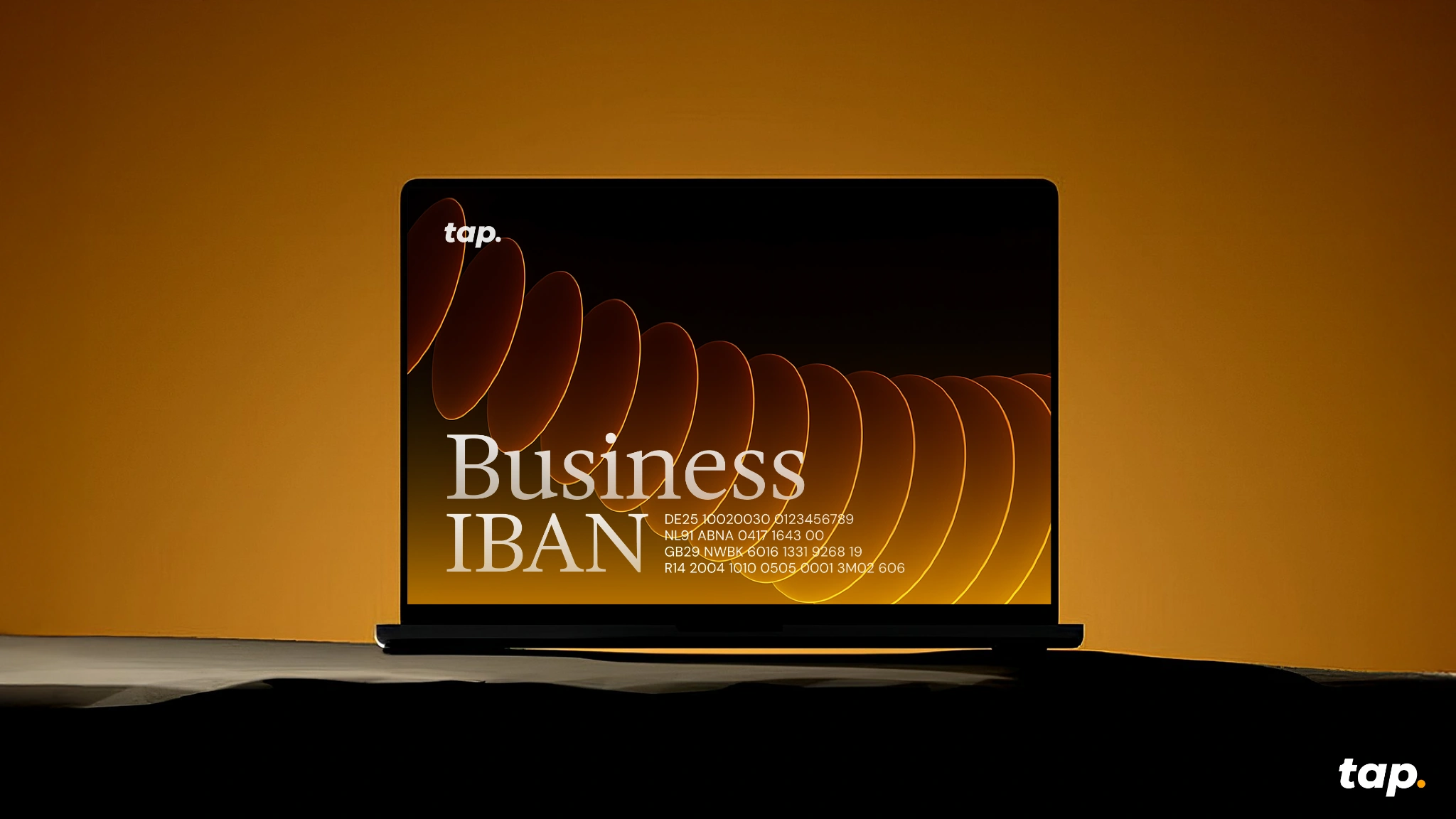
Managing payments across borders remains one of the biggest operational challenges for expanding businesses. While digital transformation has touched nearly every aspect of commerce, international banking is currently lagging behind with separate systems for crypto and traditional currency transactions, creating unnecessary complexity.
Tap solves this problem by offering each business a multi-currency account with a dedicated IBAN that functions as a bridge between these two financial worlds. For businesses handling both crypto and fiat currencies, this means one unified system rather than juggling multiple accounts and conversion processes. This isn't just convenient - it directly impacts your bottom line by reducing transaction fees, speeding up settlements, and simplifying reconciliation.
If you're handling international payments or considering crypto adoption, this could significantly streamline your financial operations. Here's what you need to know.
What is a business IBAN?
An IBAN (International Bank Account Number) serves as your business's financial passport - a standardised identifier recognised across 78+ countries. Unlike traditional account numbers, a Business IBAN follows a structured format that includes country codes, bank identifiers, and your unique account number.
What sets Tap's approach apart is the integration of this established banking standard with crypto functionality. Instead of operating in parallel financial universes, your transactions (whether in euros, dollars, or Bitcoin) flow through a single identifiable channel.
For finance teams, this means the end of reconciliation nightmares. For your customers and partners, it means one consistent payment destination regardless of their preferred currency.
How Business IBANs Work
The mechanics behind modern business transactions
A Business IBAN functions as the digital coordinates for your company's financial location in the global banking ecosystem. When properly implemented, it creates a frictionless path for money to flow into and out of your business regardless of currency type or originating country.
Sending and receiving payments
When receiving payments, your Business IBAN acts as a universal identifier that works across different payment systems. Clients simply enter your IBAN (and sometimes BIC code) into their banking platform, eliminating the confusion of different account number formats across countries.
For outgoing payments, the process works in reverse. You provide the recipient's IBAN, specify the amount, and Tap's platform handles the routing complexities behind the scenes. This standardisation prevents the common errors that lead to payment delays and rejection fees.
What separates Tap's system from conventional banking is the integration layer that works with both crypto and traditional currencies. When a client pays in Bitcoin, for example, you can choose to receive it as cryptocurrency or have it automatically converted to your preferred fiat currency before it reaches your account.
Banking networks demystified
Business IBANs interact with several key payment networks:
SEPA (Single Euro Payments Area): Covering 36 European countries, SEPA processes euro-denominated transfers typically within one business day at low fixed costs. Your Business IBAN automatically routes euro payments through this network without requiring a separate setup.
SWIFT (Society for Worldwide Interbank Financial Telecommunication): The backbone of international banking, SWIFT connects over 11,000 financial institutions worldwide.
Real-world transaction example
Consider a UK-based e-commerce business receiving payment from a German customer:
- The customer initiates a €5,000 payment to the merchant's business IBAN
- The transaction enters the SEPA network and arrives in the merchant's Tap account within hours
- The merchant can either keep the funds in euros or convert to GBP at their preferred timing
- If choosing to convert, Tap executes the exchange at market rates with minimal spread
- The funds become available for business operations, supplier payments, or withdrawal
This same process that once required multiple accounts, banking relationships, and days of processing now happens automatically through a single business IBAN. For businesses managing dozens or hundreds of such transactions monthly, the efficiency gains and cost savings compound significantly.
The ability to handle these complex financial pathways through one unified system represents the core value proposition of modern business IBANs - simplicity on the surface, sophisticated routing underneath.
Cross-border advantages that impact your bottom line
The practical benefits of a business IBAN become immediately apparent in cross-border transactions:
- Reduced rejection rates: correctly formatted IBANs virtually eliminate payment failures due to incorrect account details
- Faster settlement times: direct routing through the SEPA network for European transactions
- Lower transaction costs: fewer intermediaries means fewer fees eating into your margins
- Simplified compliance: clearer transaction trails for more straightforward reporting
Bridging crypto and traditional finance
The crypto market now represents a $2 trillion opportunity that many businesses struggle to tap into due to technical and operational barriers. A business account with Tap eliminates these obstacles by providing:
- Seamless conversion between crypto and fiat currencies
- Consolidated financial reporting across all currency types
- Regulatory compliance built into the platform
- Reduced exposure to crypto volatility through instant conversion options
For businesses cautiously exploring crypto acceptance, this hybrid approach offers a low-risk entry point without requiring major infrastructure changes.
Implementation without disruption
Setting up a business account through Tap requires minimal operational changes:
- Fill in the contact form to initiate a callback
- Complete the business account set-up and verification process
- Receive your unique account with IBAN
- Update payment details with clients and suppliers
- Integrate with your existing accounting systems
The entire process typically takes less than 48 hours, with Tap's team handling the technical heavy lifting.
Is a Tap business account right for your growth strategy?
It's worth considering a business account if your company:
- Operates in multiple countries or currencies
- Needs to reduce payment processing costs
- Wants to accept crypto payments without complexity
- Are looking to streamline financial operations
As payment landscapes continue evolving, businesses that implement flexible, future-proof solutions gain a significant competitive advantage in customer experience and operational efficiency.
Explore how a business IBAN could fit into your financial infrastructure by visiting Tap's business solutions page, from where a dedicated account manager can discuss potential savings based on your specific transaction patterns.
The business world won't wait for outdated payment systems to catch up. The question isn't whether you need more efficient payment solutions - it's how quickly you can implement them.
Let’s make your cross-border payments simple. Schedule a chat with our expert team and explore how Tap can work for your business.

The crypto market just pulled off one of its boldest recoveries in recent memory. What began as a violent sell-off on October 10 has given way to a surprisingly strong rebound. In this piece, we’ll dig into “The Great Recovery” of the crypto market, how Bitcoin’s resilience particularly stands out in this comeback, and what to expect next…
The Crash That Shook It All
On October 10, markets were rattled across the board. Bitcoin fell from around $122,000 down to near $109,000 in a matter of hours. Ethereum dropped into the $3,600 to $3,700 range. The sudden collapse triggered massive liquidations, nearly $19 billion across assets, with $16.7B in long positions wiped out.
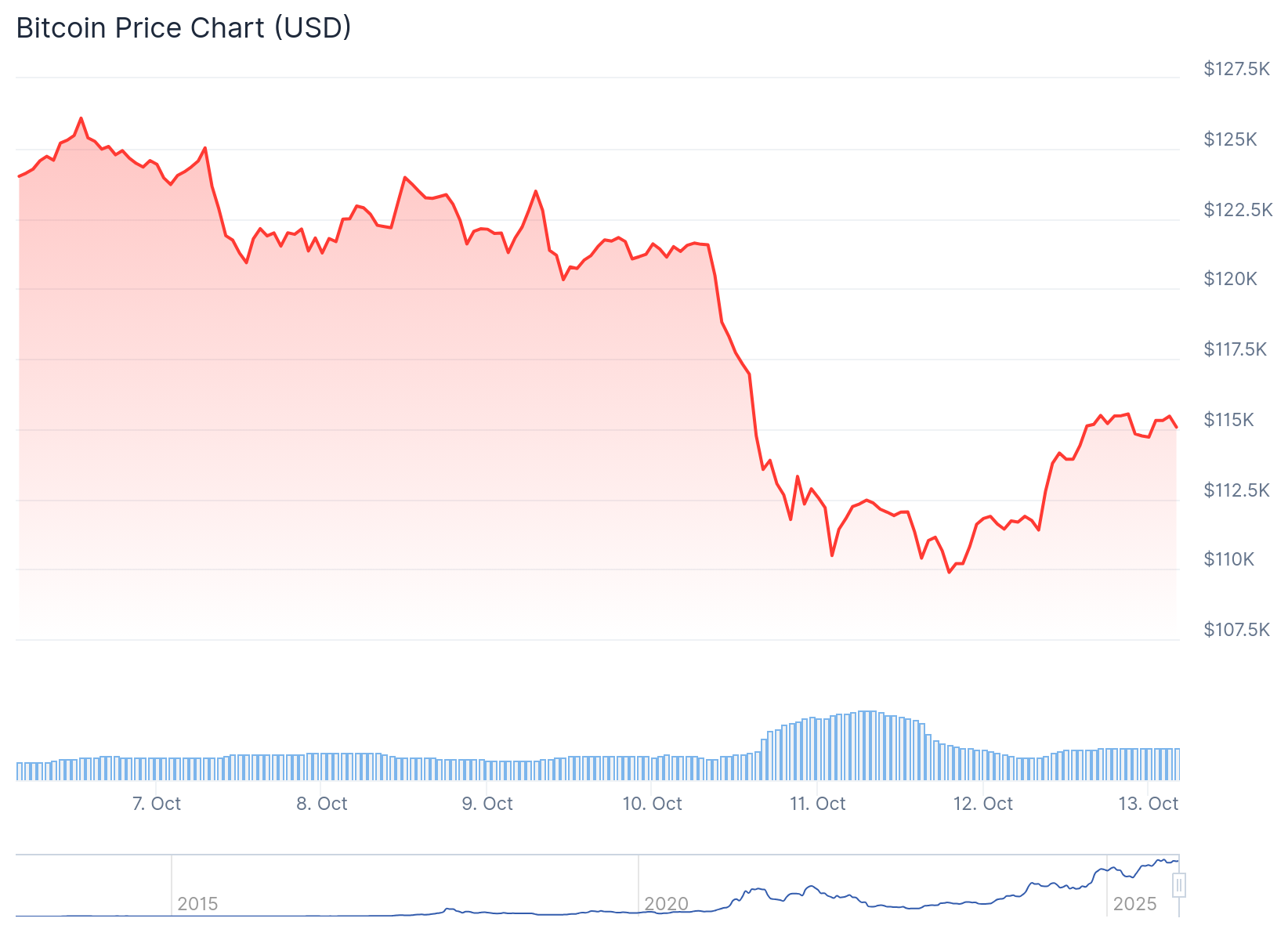
That kind of forced selling, often magnified by leverage and thin liquidity, created a sharp vacuum. Some call it a “flash crash”; an overreaction to geopolitical news, margin stress, and cascading liquidations.
What’s remarkable, however, is how quickly the market recovered.
The Great Recovery: Scope and Speed
Within days, many major cryptocurrencies recouped large parts of their losses. Bitcoin climbed back above $115,000, and Ethereum surged more than 8%, reclaiming the $4,100 level and beyond. Altcoins like Cardano and Dogecoin led some of the strongest rebounds.
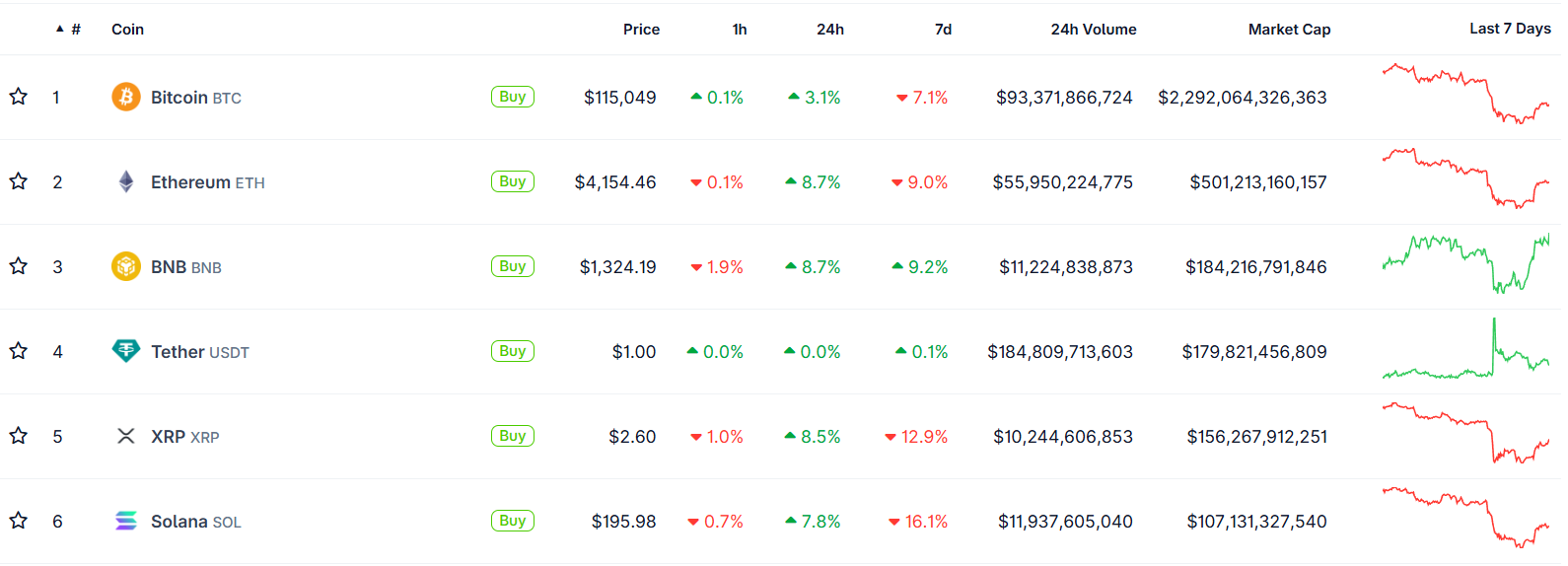
One narrative gaining traction is that this crash was not a structural breakdown but a “relief rally”, a market reset after overleveraged participants were squeezed out of positions. Analysts highlight that sell pressure has eased, sentiment is stabilizing, and capital is re-entering the market, all signs that the broader uptrend may still be intact.
“What we just saw was a massive emotional reset,” Head of Partnerships at Arctic Digital Justin d’Anethan said.
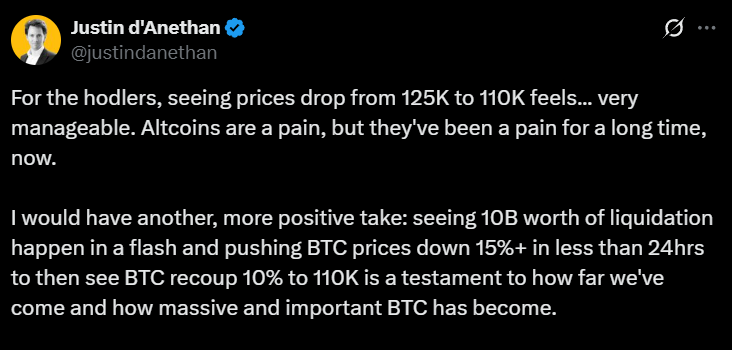
“I would have another, more positive take: seeing 10B worth of liquidation happen in a flash and pushing BTC prices down 15%+ in less than 24hrs to then see BTC recoup 10% to 110K is a testament to how far we've come and how massive and important BTC has become,” he posted on 𝕏.
Moreover, an important datapoint stands out. Exchange inflows to BTC have shrunk, signaling that fewer holders are moving coins to exchanges for sale. This signals that fewer investors are transferring their Bitcoin from personal wallets to exchanges, which is a common precursor to selling. In layman terms, coins are being held rather than prepared for trade.
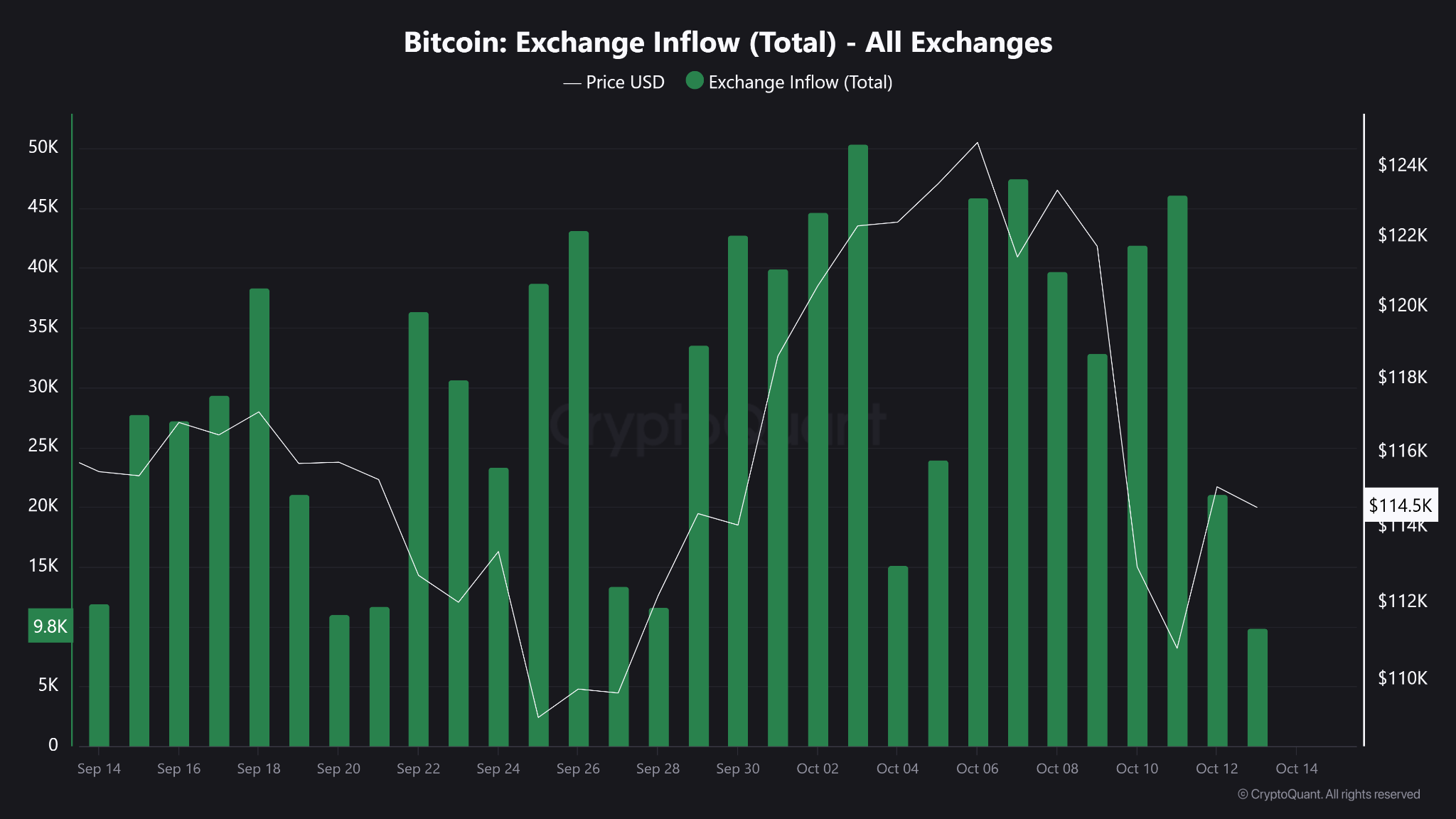
Bitcoin’s Backbone: Resilience Under Pressure
Bitcoin’s ability to rebound after extreme volatility has long been one of its defining traits. Friday’s drop admittedly sent shockwaves through the market, triggering billions in liquidations and exposing the fragility of leveraged trading.
Yet, as history has shown, such sharp pullbacks are far from new for the world’s largest cryptocurrency. In its short history, Bitcoin has endured dozens of drawdowns exceeding 10% in a single day (from the infamous “COVID crash” of 2020 to the FTX collapse in 2022) only to recover and set new highs months later.
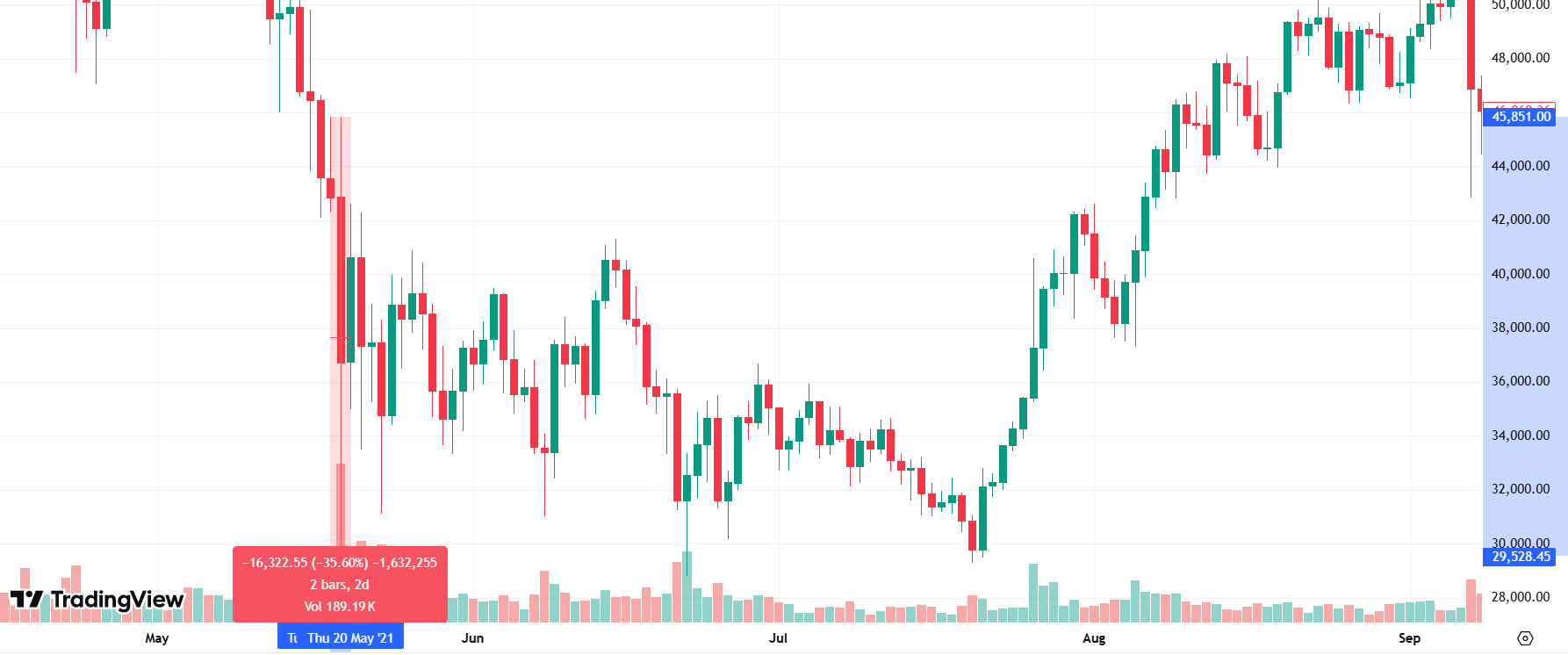
This latest event, while painful, highlights a maturing market structure. Since the approval of spot Bitcoin ETFs in early 2024, institutional involvement has deepened, creating greater liquidity buffers and stronger institutional confidence. Even as billions in leveraged positions were wiped out, Bitcoin has held firm around the $110,000 zone, a level that has since acted as psychological support.
What to Watch Next
The key question now is whether this rebound marks a short-term relief rally or the start of a renewed uptrend. Analysts are closely watching derivatives funding rates, on-chain flows, and ETF inflows for clues. A sustained increase in ETF demand could provide a steady bid under the market, offsetting the effects of future liquidation cascades. Meanwhile, Bitcoin’s ability to hold above $110,000 (an area of heavy trading volume) may serve as confirmation that investor confidence remains intact.
As the market digests the events of October 10, one lesson stands out. Bitcoin’s recovery isn’t just a matter of luck, it’s a reflection of underlying market structure that can absorb shocks. It is built on a growing base of long-term holders, institutional adoption, and a financial system increasingly intertwined with digital assets. Corrections, however dramatic, are not signs of weakness; they are reminders of a maturing market that is striding towards equilibrium.
Bottom Line
The crash on October 10 was brutal, there’s no denying that. It was one of the deepest and fastest in recent memory. But the recovery has been equally sharp. Rather than exposing faults, the rebound has underscored the market’s adaptability and Bitcoin’s central role.
The market consensus is seemingly leaning towards a reset; not a reversal. The shakeout purged excess leverage, and the comeback underlined demand. If Bitcoin can maintain that strength, and the broader market keeps its footing in the coming days, this could mark a turning point rather than a cave-in.
.webp)
Vous avez sûrement déjà entendu parler de ChatGPT – cet assistant IA qui revient dans toutes les conversations autour de la productivité et de la technologie. Et honnêtement ? Il est à la hauteur de sa réputation.
Imaginez un ami très intelligent, disponible à tout moment : que ce soit pour vous aider sur un projet de travail, rédiger un e-mail, ou satisfaire une curiosité soudaine à 23h.
Mais voilà ce qu’on ne vous dit pas toujours au départ : toutes les formules de ChatGPT ne se valent pas. Il y a une vraie différence entre la version gratuite (pratique mais parfois limitée) et les formules payantes (plus rapides, plus puissantes, plus stables).
Que vous soyez étudiant au budget serré ou professionnel à la recherche d’un vrai outil de productivité, comprendre ces différentes formules peut vous aider à choisir celle qui correspond à vos besoins.
Les formules ChatGPT en détail (2025)
Décryptons ce que chaque plan propose, et ce que vous obtenez réellement.
| Plan | Monthly Cost | Annual Cost | Best For |
|---|---|---|---|
| Free | $0 | $0 | Casual users, testing |
| Plus | $20 | $20 | Individual professionals |
| Team | $30/user | $25/user | Small teams, startups |
| Pro | $200/user | $200/user | Power users, researchers |
| Enterprise | ~$60+/user | Custom pricing | Large organisations |
✅ Formule gratuite
Tarif : 0 $
Fonctionnalités :
- Accès à GPT-4o mini
- Accès limité à GPT-4o
- Mode vocal standard
- Téléchargement de fichiers
- Génération d’images
- Navigation web
- Analyse avancée de données
Pour qui ?
Parfait pour découvrir l’outil sans engagement. Une bonne façon de tester ce que ChatGPT peut faire, même si certaines fonctions sont limitées.
✅ Formule Plus
Tarif : 20 $ / mois
Fonctionnalités :
- Jusqu’à 80 messages par tranche de 3 heures
- Accès prioritaire à GPT-4o
- Réponses plus rapides
- Mode vocal avancé
- Accès anticipé aux nouvelles fonctionnalités
- Création de GPT personnalisés
Pour qui ?
Idéal pour les indépendants, étudiants ou pros qui utilisent l’IA régulièrement. Cette formule transforme ChatGPT en assistant de travail fiable, disponible et performant.
✅ Formule Team
Tarif : 30 $ / utilisateur / mois ou 25 $ avec engagement annuel
Fonctionnalités :
- Tout ce qui est inclus dans Plus
- Collaboration entre 2 utilisateurs ou plus
- Espace de travail partagé
- Données privées (non utilisées pour l'entraînement)
- Contrôle administrateur et suivi d’utilisation
- GPT personnalisés pour l’équipe
Pour qui ?
Conçue pour les petites équipes ou startups qui veulent travailler ensemble sur des projets IA tout en gardant un cadre sécurisé et organisé.
✅ Formule Pro
Tarif : 200 $ / mois / utilisateur
Fonctionnalités :
- Accès illimité à GPT-4o
- Raisonnement avancé
- Performances de niveau recherche
- Ressources de calcul premium
- Toutes les fonctionnalités précédentes
Pour qui ?
Destinée aux utilisateurs intensifs : chercheurs, développeurs, ingénieurs. Si vous utilisez l’IA comme outil principal au quotidien, cette formule offre un accès sans limites aux capacités les plus avancées.
✅ Formule Enterprise
Tarif : à partir de 60 $ / utilisateur / mois (minimum 150 utilisateurs sur 12 mois)
Fonctionnalités :
- Confidentialité et sécurité renforcées
- Connexions avec les outils internes (Drive, SharePoint, GitHub…)
- Déploiement sur mesure
- Contrôles d’accès avancés
- Support dédié
- Limites personnalisées
Pour qui ?
Pensée pour les grandes entreprises qui souhaitent intégrer l’IA à leur infrastructure tout en respectant les standards de conformité et de sécurité.
Quelle formule choisir ?
Choisir une formule, c’est un peu comme choisir un forfait mobile : vous voulez les bonnes options, sans payer pour ce dont vous n’avez pas besoin.
- Étudiants
Commencez avec la version gratuite. Elle suffit pour la recherche, l’aide à la rédaction, ou les révisions. Si vous constatez des limites fréquentes, la formule Plus peut offrir plus de fluidité pendant les périodes chargées. - Freelances et pros en solo
La formule Plus (20 $/mois) est souvent le meilleur compromis. Que vous soyez créateur de contenu, consultant ou entrepreneur, vous avez accès à des fonctionnalités stables et performantes. - Développeurs et profils techniques
Plus fonctionne pour un usage ponctuel. Pour les projets intensifs ou la génération de code à grande échelle, la formule Pro permet de travailler sans interruption. - Petites équipes et startups
Team (25-30 $/utilisateur) apporte un vrai cadre de travail collaboratif avec la sécurité en prime. Idéal pour les équipes de 2 à 10 personnes. - Grandes entreprises
Enterprise, avec son déploiement personnalisé, permet une intégration complète de l’IA dans les process métiers tout en respectant les exigences internes.
Points à connaître : limites et coûts cachés
Avant de vous lancer, quelques éléments importants à garder en tête :
✅ Usage de l’API
Si vous créez des applis qui utilisent l’API de ChatGPT, le tarif est indépendant des plans ci-dessus. Il est calculé par jeton (par ex. GPT-4 : 0,012 $/jetons de prompt, 0,024 $/jetons de réponse), auxquels s’ajoutent souvent des coûts de serveur ou d’optimisation.
✅ Limitations de messages
Même les formules payantes ont des plafonds. La version gratuite est assez limitée. La formule Plus élargit ces capacités mais n’est pas illimitée. Si vous êtes un utilisateur très actif, ces limites peuvent se faire sentir.
✅ Accès différé à certaines fonctionnalités
Les nouveautés arrivent d’abord pour les abonnés Plus, Pro ou Enterprise. Les utilisateurs de la version gratuite doivent parfois attendre plusieurs mois.
✅ Restrictions sur les fichiers
Même si les uploads sont autorisés, la taille et la complexité des fichiers peuvent poser problème selon les cas d’usage.
Et les alternatives à ChatGPT ?
ChatGPT est top, mais ce n’est pas le seul dans la course. Voici quelques alternatives intéressantes :
- Claude AI (Anthropic)
Tarifs : version gratuite + Pro à 20 $/mois
Atouts : très bon pour l’analyse, longues fenêtres de contexte
Idéal pour : ceux qui travaillent sur des documents longs ou complexes - Perplexity AI
Tarifs : gratuit + Pro à 20 $/mois
Atouts : recherches web intégrées, sources citées
Idéal pour : utilisateurs orientés recherche et vérification de sources - DeepSeek
Tarifs : version gratuite + plans individuels (20–50 $/mois) et offres pro sur devis
Atouts : bonnes performances à coût réduit
Idéal pour : ceux qui veulent une alternative solide à prix modéré - Google Gemini
Tarifs : version gratuite + AI Premium via Google One (20 $/mois)
Atouts : intégration poussée à l’écosystème Google
Idéal pour : utilisateurs déjà investis dans les outils Google
Conclusion : ChatGPT vaut-il son prix en 2025 ?
Tout dépend de l’usage que vous en faites.
- Si vous l’utilisez occasionnellement, la version gratuite est déjà très capable.
- Si vous y revenez chaque jour pour le travail, la formule Plus à 20 $ est vite rentabilisée.
- Pour les équipes, les offres Team et Enterprise permettent de structurer les usages et de professionnaliser les outils.
Bonne nouvelle : vous n’avez pas besoin de tout décider aujourd’hui. Essayez les versions gratuites de ChatGPT, Claude ou Perplexity, et voyez celle qui colle le mieux à votre style de travail. Ensuite, passez à la vitesse supérieure quand vous êtes prêt.
L’intelligence artificielle devient peu à peu aussi essentielle que l’e-mail ou Google Docs. La question n’est plus “si” vous allez l’utiliser, mais “comment” et “avec quoi”.
TAP'S NEWS AND UPDATES
What’s a Rich Text element?
What’s a Rich Text element?The rich text element allows you to create and format headings, paragraphs, blockquotes, images, and video all in one place instead of having to add and format them individually. Just double-click and easily create content.
The rich text element allows you to create and format headings, paragraphs, blockquotes, images, and video all in one place instead of having to add and format them individually. Just double-click and easily create content.Static and dynamic content editing
Static and dynamic content editingA rich text element can be used with static or dynamic content. For static content, just drop it into any page and begin editing. For dynamic content, add a rich text field to any collection and then connect a rich text element to that field in the settings panel. Voila!
A rich text element can be used with static or dynamic content. For static content, just drop it into any page and begin editing. For dynamic content, add a rich text field to any collection and then connect a rich text element to that field in the settings panel. Voila!How to customize formatting for each rich text
How to customize formatting for each rich textHeadings, paragraphs, blockquotes, figures, images, and figure captions can all be styled after a class is added to the rich text element using the "When inside of" nested selector system.
Headings, paragraphs, blockquotes, figures, images, and figure captions can all be styled after a class is added to the rich text element using the "When inside of" nested selector system.What’s a Rich Text element?
What’s a Rich Text element?The rich text element allows you to create and format headings, paragraphs, blockquotes, images, and video all in one place instead of having to add and format them individually. Just double-click and easily create content.
The rich text element allows you to create and format headings, paragraphs, blockquotes, images, and video all in one place instead of having to add and format them individually. Just double-click and easily create content.Static and dynamic content editing
Static and dynamic content editingA rich text element can be used with static or dynamic content. For static content, just drop it into any page and begin editing. For dynamic content, add a rich text field to any collection and then connect a rich text element to that field in the settings panel. Voila!
A rich text element can be used with static or dynamic content. For static content, just drop it into any page and begin editing. For dynamic content, add a rich text field to any collection and then connect a rich text element to that field in the settings panel. Voila!How to customize formatting for each rich text
How to customize formatting for each rich textHeadings, paragraphs, blockquotes, figures, images, and figure captions can all be styled after a class is added to the rich text element using the "When inside of" nested selector system.
Headings, paragraphs, blockquotes, figures, images, and figure captions can all be styled after a class is added to the rich text element using the "When inside of" nested selector system.What’s a Rich Text element?
What’s a Rich Text element?The rich text element allows you to create and format headings, paragraphs, blockquotes, images, and video all in one place instead of having to add and format them individually. Just double-click and easily create content.
The rich text element allows you to create and format headings, paragraphs, blockquotes, images, and video all in one place instead of having to add and format them individually. Just double-click and easily create content.Static and dynamic content editing
Static and dynamic content editingA rich text element can be used with static or dynamic content. For static content, just drop it into any page and begin editing. For dynamic content, add a rich text field to any collection and then connect a rich text element to that field in the settings panel. Voila!
A rich text element can be used with static or dynamic content. For static content, just drop it into any page and begin editing. For dynamic content, add a rich text field to any collection and then connect a rich text element to that field in the settings panel. Voila!How to customize formatting for each rich text
How to customize formatting for each rich textHeadings, paragraphs, blockquotes, figures, images, and figure captions can all be styled after a class is added to the rich text element using the "When inside of" nested selector system.
Headings, paragraphs, blockquotes, figures, images, and figure captions can all be styled after a class is added to the rich text element using the "When inside of" nested selector system.
Say goodbye to low-balance stress! Auto Top-Up keeps your Tap card always ready, automatically topping up with fiat or crypto. Set it once, and you're good to go!
Read moreWhat’s a Rich Text element?
What’s a Rich Text element?The rich text element allows you to create and format headings, paragraphs, blockquotes, images, and video all in one place instead of having to add and format them individually. Just double-click and easily create content.
The rich text element allows you to create and format headings, paragraphs, blockquotes, images, and video all in one place instead of having to add and format them individually. Just double-click and easily create content.Static and dynamic content editing
Static and dynamic content editingA rich text element can be used with static or dynamic content. For static content, just drop it into any page and begin editing. For dynamic content, add a rich text field to any collection and then connect a rich text element to that field in the settings panel. Voila!
A rich text element can be used with static or dynamic content. For static content, just drop it into any page and begin editing. For dynamic content, add a rich text field to any collection and then connect a rich text element to that field in the settings panel. Voila!How to customize formatting for each rich text
How to customize formatting for each rich textHeadings, paragraphs, blockquotes, figures, images, and figure captions can all be styled after a class is added to the rich text element using the "When inside of" nested selector system.
Headings, paragraphs, blockquotes, figures, images, and figure captions can all be styled after a class is added to the rich text element using the "When inside of" nested selector system.BOOSTEZ VOS FINANCES
Prêt à passer à l’action ? Rejoignez celles et ceux qui prennent une longueur d’avance. Débloquez de nouvelles opportunités et commencez à façonner votre avenir financier.
Commencer







